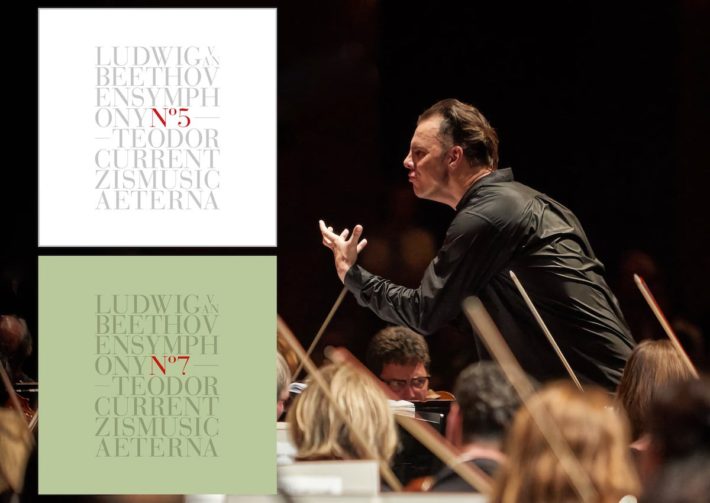Image: Alexandra Muravyeva
Teodor Currentzis continues to be a divisive figure in the world of Classical Music. The release of these new recordings caused a stir because of his insistence that each symphony be released separately (even though both works would easily fit on one CD). His reasoning? According to Sony’s website, “For Currentzis each symphony is similar to a novel. Every recording should be a unique item.” But the reality is that since so many of us listen via streaming or download, it is the listener, not the conductor or record label, who decides on the order and number of ‘novels.’ Ultimately, the only question is whether these new performances capture the genius of Beethoven. Happily, they do.
The fifth symphony’s opening movement is fiercely propulsive. Accents are sharp and the brass have plenty of bite. While the strings count is surprisingly large for a historically informed performance (12/10/8/8/6), balance between the sections is beautifully managed, aided by a recording that is clear, transparent, but warmly resonant. Currentzis has developed a disciplined ensemble that plays with unanimity and plenty of panache.
In previous recordings Currentzis has added articulations and dynamics not found in the score, a practice he continues here. These changes, for the most part, are convincing. The slight relaxation of tempo (and ferocity) at the beginning of the development is effective. But in the recapitulation, he slows down just before the oboe solo, as if it will be the fully-fledged cadenza of a concerto, thereby completely negating Beethoven’s intended disruption.
The Andante is beautifully phrased, rubato sparingly used. The playing is often achingly beautiful. Currentzis and his players elucidate each strand of Beethoven’s increasingly complex web of polyphony. This is a thoughtful and deeply felt interpretation that unites the best qualities of historically informed performance with the ‘old-fashioned’ sensibilities of romantic interpretation.
Related Classical Music Reviews
- Double Review: Chopin Piano Concertos – Grosvenor, Yundi
- Review: Chopin – Complete Nocturnes – Jan Lisiecki
- Review: Four Recent Chopin Albums (2021)
The Scherzo is played with thrilling brio, though some listeners may find the Trio’s quick tempo a tad relentless (though that is exactly what Beethoven’s metronome marking asks for). The fourth movement’s triumphant C major initial chords have tremendous impact, trombones and contrabassoon clearly heard in the mix. (In fact, the contrabassoon is heard with great clarity throughout the movement.) Currentzis allows himself a greater degree of tempo flexibility than one often hears, most of it entirely convincing, though around the 4-minute mark it may strike some as close to mannerism. In the final section of the Coda, Currentzis pushes his players ever faster, their struggle to clearly articulate the music only adding to the music’s exultant exhilaration.
In the seventh symphony Currentzis uncovers lots of inner detail in the accompanying string patterns. While some of it proves interesting, it often distracts from the main melodic material. musicAeterna’s unanimous phrasing and articulation continually impress, the music’s buoyancy and momentum eminently danceable. Again, there are little unexpected moments of emphasis and mild dynamic tweaking (especially around 13’10”) that could prove wearisome on repeated listening. And throughout the performance I wanted the horns to ring out more, as they do so thrillingly in the Pittsburgh/Honeck recording.
The second movement’s opening is inaudible (Beethoven’s marking is only piano), but the playing is gorgeous and deeply felt. Currentzis and his players find a wistful yearning in Beethoven’s music that is deeply touching. Balance between sections is again excellent, and the clarity and weightiness of the timpani throughout this movement is particularly effective. The same care over clarifying polyphonic texture is heard, and the music builds to a powerful climax (6’13”) though for some the clipped phrasing may rob the climax of its cumulative power. The harmonic shift at 6’30” is magical, bringing a momentary oasis of calm.
The Scherzo is explosive and rhythmically arresting, though more flexibility with the fanfare pronouncements at 3’38” might add greater nobility and emphasis. I expected Currentzis’ tempo for the final movement to be quicker, anticipating he might try to outdo ORR/Gardiner or Vienna/Kleiber. Instead, the tempo is roughly 10 clicks below Beethoven’s metronome mark of half note=72. Yet through careful attention to detail, weightier attack, and more varied orchestral color, the performance has a sinewy strength and power that completely convinces (Again, I wish the horns had played out more).
A distinguishing attribute of both performances is Currentzis’ integration of historically informed playing and colors with a more ‘romantic’ interpretative ideal. Gardiner’s live readings may have a higher level of electricity, and there is an opulent richness in orchestral sound in both the Pittsburgh/Honeck and Vienna/Kleiber recordings, but these new performances are exceptional. Each is intensely alive, searching and discovering the wonders of these two monuments of Western music.

Beethoven – Symphony No. 5, Op. 67 / Symphony No. 7, Op. 92
musicAeterna
Teodor Currentzis – Conductor
Sony Classical, CD 19075884972 (No. 5), CD 19439743772 (No. 7)
Recommended Comparisons
Read more classical music reviews or visit The Classic Review Amazon store
Follow Us and Comment:
[wd_hustle id=”HustlePostEmbed” type=”embedded”]











